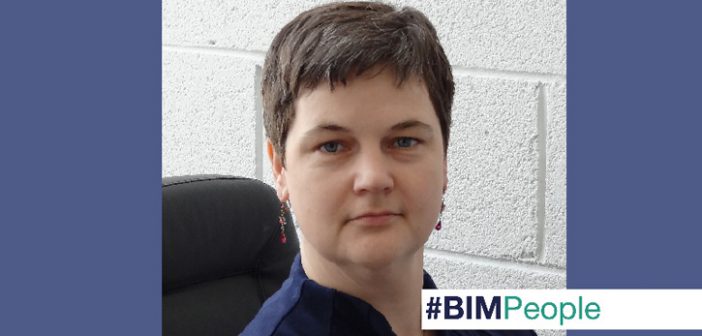Avril Behan, FSCSI, FRICS, MRSPSoc, BIM Programmes Manager & Lecturer, Assistant Head of School at Dublin Institute of Technology (DIT)
Avril qualified from DIT’s Geo-Surveying Diploma in 1994. In 1998, she gained an MSc in Remote Sensing, Digital Image Processing & Applications from the University of Dundee.
In 2012, she graduated from Trinity College Dublin with a PhD in the application of Geomatics Techniques to the study of Architectural History. Avril is a Chartered Geomatics Surveyor.
She has worked with the Irish Office of Public Works, Swissair Photo AG in Switzerland, and Delft University of Technology, Netherlands. Avril joined the Department of Geomatics at DIT in 2003 where she specialised in the teaching of CAD, photogrammetry and Remote Sensing. In 2014, she moved from the School of Surveying & Construction Management into the newly-formed School of Multidisciplinary Technologies.
BIMIreland.ie recently spoke to Avril about her work in BIM and BIM at DIT.
Please tell us how you got interested in BIM?
My original contact with BIM was when I started using the 2007 release of Autodesk Civil 3D as a tool to enable Geomatics students to directly download the survey data captured by a range of total station, GNSS (Global Navigation Satellite Systems), photogrammetric, and airborne and ground-based laser scanning equipment into a Civil Engineering, AutoCAD and GIS environment. Geomatics professionals have always collected 3D data but were required to translate this into 2D for most uses in the construction and planning sectors. However, for over 20 years Geomatics data has been structured into spatial databases linked to graphical interfaces in the form of Geographic Information Systems for the execution of advanced modelling, mapping, planning, and decision-making at local, regional and international scales. For me, BIM’s logic of prioritising the information component behind the graphic of the model and the ability to fully exploit the power of the 3rd dimension were undeniable.
At about the same time, Malachy Mathews was introducing Revit and BIM to the Architectural Technology programme so we worked together to enable the Technologists to capitalise on the 3D data collection, handling, and management knowledge of the Geomatics professionals as collaborators in the BIM process. Shortly after, the Geomatics BSc programme introduced a Revit-based module and these two changes enabled the development of joint project work and peer-to-peer demonstrations between the two cohorts of students.
Could you tell us about DIT’s School of Multidisciplinary Technologies?
The School of Multidisciplinary Technologies was formed in October 2013 when the former Faculty of Engineering and the Faculty of the Built Environment merged into a single College, one of four comprising the Dublin Institute of Technology. The School focuses on maximising the benefit of working across the broad range of disciplines, many of them construction-related, operating on the college’s campuses at Bolton Street and Kevin Street.
We manage two common-entry Engineering programmes at levels 7 and 8 (undergraduate) from whence students enter careers in Building Services, Civil, Electrical, Electronic, Mechanical, Manufacturing, or Structural engineering. At level 9 (postgraduate) we manage programmes related to Applied Computing for Engineering and Built Environment professionals as well as the suite of BIM programmes.
“The College of Engineering & Built Environment’s BIM Strategy, which focused on embedding BIM into all construction-related undergraduate teaching as well as developing specialised postgraduate BIM content, was proposed and brought to adoption by Kevin Furlong, now of the School of Multidisciplinary Technologies, as a result of his PhD studies into collaborative education within the built environment. The momentum around BIM increased as Kevin, with Cormac Allen and Malachy Mathews of the Dublin School of Architecture, developed two CPD Diploma programmes in BIM Technologies and Collaborative BIM, and sought funding for newly unemployed built environment professionals via the Springboard initiative.” Once the strategy was adopted co-ordination of the postgraduate MSc in aBIMM and responsibility for implementation of the collaborative, undergraduate portion of the strategy moved to the School of Multidisciplinary Technologies (SMDT). SMDT liaises with the other schools to deliver high-quality content and teaching in a collaborative environment and development of DIT’s Big BIM Room was an essential element of this plan.
Could you tell us about your work in BIM at DIT? Can you tell us about DIT’s BIM Courses?
I manage our suite of postgraduate modules and programmes from the MSc in aBIMM and I have responsibility for implementing the collaborative portion of the College of Engineering & Built Environment’s BIM strategy.
The MSc currently runs as a 2.5-year, part-time, evening programme with delivery on two evenings per week supported by online collaboration environments and virtual access to software. Students move through the programme via flexible learning paths which mean that they can enter at different levels (using DIT’s Recognition of Prior Learning policies), leave with different outcomes (from CPD modules to the 1-year Postgraduate Certificate in BIM Technologies, the 2-year Postgraduate Diploma in Collaborative BIM or the 2.5-year MSc in Applied Building Information Modelling & Management), and progress at a pace that suits, up to a maximum duration of 6 years.
Year one starts with discipline-specific technologies in the areas of architecture/architectural technology, civil & structural engineering, geomatics engineering, mechanical & electrical engineering, and quantity surveying & construction management before progressing into cross-domain awareness development, underpinning practice with theory, and federated BIM collaboration. The second year focussed on collaborative BIM processes and a large, real-world based multidisciplinary collaboration project which this year is supported by the early roll-out of Autodesk’s Revit for Collaboration tools. Students also undertake a free elective. The final year comprises an individual Capstone Experience which is an applied project based around current or future BIM-related issues, topics or problems and which is written up in the form of contemporary, online e-portfolio and an industry-focussed paper.
Also at postgraduate level, DIT with CitA offers the MSc in Construction Informatics while there are already, or shortly will be, BIM or BIM-related modules in programmes on Geospatial Engineering, Sustainable Infrastructure, HVAC Systems, Facilities Management, and Quantity Surveying (Conversion and M&E).
At undergraduate level, BIM is being taught as it applies to specific disciplines in Architectural Technology, Architecture, Building Services Engineering, Construction Management, Geomatics, Electrical Services Engineering, and Quantity Surveying and many of these programmes will, from September 2016, be involved in a multidisciplinary collaboration project enabled by our Big BIM Room.
As well as my management roles, I also teach on the MSc in aBIMM, the MSc in Geospatial Engineering, the BSc in Geomatics as well as providing guest lectures on BIM across the college.
Please give the readers some information on the DIT BIM Room?
The BIM room is a development that is essential to ensuring the market-readiness of DIT’s graduates at all levels. This is a large, flexible learning space where collaboration takes place around team stations, each of which is equipped with a large screen, Wi-Fi, and electrical power, and from which each team can take control of the room’s main audio-visual facilities. Demand for use of the room exceeds availability as the environment encourages true collaboration. SMDT would like to acknowledge the investments made in the room by a number of budget-holders throughout DIT. Some video footage of collaboration underway in the room is available at www.dit.ie/bim.
Have you got any upcoming BIM research projects? Can you tell us about BIM research projects in DIT?
Up until now we have been focussing on rolling out the different stages of the aBIMM MSc and our undergraduate BIM provision. Before the summer approximately 10 – 15 of our current Stage 2 students will launch their Capstone Experiences and I have no doubt that a number of these will result in further research activities at PhD and, possibly, post-doctoral level. We are also currently examining a number of industry partnership options and hope to be able to announce something in this area soon.
A further development is around the linkage between Lean and BIM. Following this year’s very successful rollout of a Lean BIM module, delivered by Kieran O’Neill, former Lead Designer at Intel, we are working with the Irish Community of Practice of the Lean Construction Institute both in relation to research and taught delivery. Another of this year’s new modules, BIM for Clients and Asset Managers, delivered by Vincent Gibson, Facility Management Consultant, has opened some other doors to FM-focussed researched. We will also be actively involved in Enterprise Ireland’s BICP, managed through CitA.
Are you satisfied with the quality of BIM education and research in Ireland?
I think that there is significant opportunity to do more both by way of collaborative teaching and in terms of research. However, I am certain that we are on the right path and that all of the important stakeholders have now recognised the importance of developing Ireland’s BIM capability, at all levels in the construction sector.
What are your observations of multidisciplinary BIM projects in DIT?
Over the last 4 years of delivery of multidisciplinary BIM projects (between the CPD Diplomas and now the MSc suite) we have seen massive changes, almost all of which have been beneficial. The available technologies that support Collaborative working and Common Data Environments are unrecognisable relative to when we started. The usability of these tools has increased so much that professionals no longer need to battle against restrictions but can rather exploit the potential. Knowledge–sharing and knowledge-exchange are more feasible and, as a result, trust is growing. However, the issues which impose barriers on collaboration, such as contracts, risk avoidance, and uncertainly in relation to the law, are increasingly identified as urgently in need of solution. Ireland’s variation on the UK BIM mandate is also a frequent topic for discussion.
Will BIM affect the duties and responsibilities of the professions?
Absolutely it will. Already the jobs being advertised through DIT are changing to all require BIM competence and while proven abilities in relation to teamwork were always mentioned, they are now mandated. We have found that the inclusion of our cross-domain modules during the first year of our programme has been a significant success as it makes seasoned professionals realise how much impact their design and operational decisions have on the other members of the BIM team. If all professions can, and are contractually allowed to, demonstrate more focus on the common good of a project than on shifting blame and avoiding risk we have a chance of significantly improving this sector and attracting the high-quality talent into it that will serve to drive it further forward. BIMIreland.ie
How do you see the Irish construction industry changing in the next decade?
I am full of hope for the Irish construction industry. This March’s CAO figures demonstrated that Irish parents are again thinking that the built environment is a good place for their children to make their futures. Improved students will mean better graduates who will, in turn, help to maintain the continuous improvement of the sector.
Certainly there are challenges to face, but as a result of the non-confrontational communication espoused by BIM and the common-sense, no waste attitude of the Lean Construction movement, I think that the industry will adapt and improve to the benefit of everyone from building users to construction company executives to site labourers.
The broadening of the BIM remit will also be massively beneficial to Ireland Inc. and to the Irish people. BIM for infrastructure, for telecoms, for utilities, and for water are only a few of the related sectors where the benefits of implementing collaborative BIM processes will be radical. Better linkage of building/infrastructure design and construction to the planning process via BIM and GIS without the need for the retrograde step back to paper is essential. Joined-up-thinking in relation to Valuations, Property Registration, Transport & Spatial Planning, and Urbanisation will allow BIM to become an enabler of social change and improvement for all citizens.
The contents of this site are subject to copyright laws and may not be reproduced in any form without the prior consent of the publishers. The views expressed in articles do not necessarily represent those of the publishers. BIMIreland.ie




